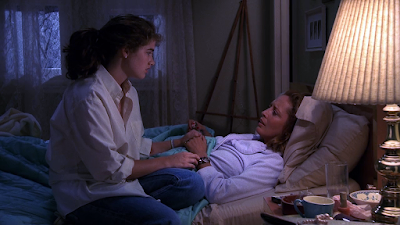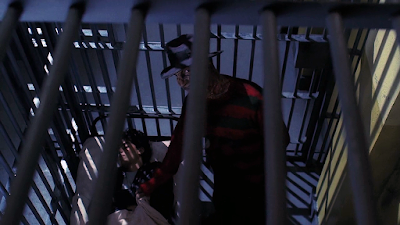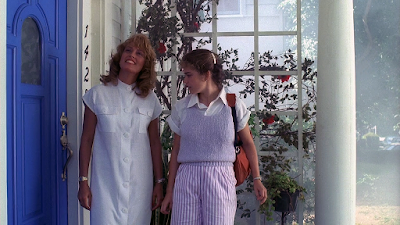
(Every month, I choose a horror film to shine a spotlight on and dig into. For the month of September, I selected the iconic 1984 slasher A Nightmare on Elm Street.)
Once upon a time, there was a story about a young girl named Nancy. Nancy lived in the land of Springwood with her three little friends Glen, Rod and Tina. Little did the four know that they were about to come under siege by a tyrant. One that Nancy's guardians, Donald and Marge, tried and failed to shield her from. One by one, Nancy's friends fell: First Tina, then Rod, then finally Glen. It all came down to Nancy to fight against the tyrant and face her fears once and for all, especially after the tyrant's destruction of her guardian Marge. Something Nancy was able to accomplish, once she learned how to properly face her fears: By reclaiming all of the energy she had given to the tyrant, she would not only be able to defeat the tyrant but also revive her fallen friends and guardian. Once she did that, the tyrant was vanquished, the fallen were revived and Nancy lived happily ever after. The end.
Except, that's not how the story ended.
When Wes Craven initially wrote A Nightmare on Elm Street, he conceived of his story to stand alone. It was to end with a happy ending where protagonist Nancy would succeed in defeating antagonist Fred Krueger and awaken to find her mother and friends happy and healthy and decidedly alive. However, one of the film's producers, Robert Shaye, insisted on removing the intended ending and replacing it with a new twist ending in which not only was Nancy still stuck in her dreams, but that she ultimately failed in her efforts to defeat Fred. Something that would ensure Craven's property would become a franchise rather than the singular entity he desired. Shaye ultimately succeeded in accomplishing this, and transformed Elm Street into a successful franchise that spawned seven sequels, a remake, a television spin-off and countless merchandise. However, when one views the original film with Craven's intended ending in mind, they can see that Shaye's ending disrupts the intentions of Craven's vision for the film: For it to be a cinematic fairy tale. Something that can be clearly seen when analyzing the film's use of tropes commonly associated with fairy tales, Jungian archetypes and the moral lessons Craven embedded within the film's screenplay.

Before diving straight to the analysis of the fairy tale tropes within Elm Street, a quick explanation of what exactly is a fairy tale must be briefed. Fairy tales are defined by writer Marina Warner as "stories that try to find the truth and give us glimpses of greater things," something that Warner believes has allowed for them to have a growing presences in the arts, including cinematic works such as Elm Street. Instructor Valerie Gokturk gives a more in depth definition: "A fairy tale is a fictional story that may feature folkloric characters [...] and enchantments, often involving a far-fetched sequence of events. [...] They have their roots in the oral tradition. Fairy tales with very similar plots, characters, and motifs are found across many different cultures." Knowing this definition of fairy tales allows for a reading of Elm Street as one to begin to take foot: Just looking over Gokturk's definition, one can argue while Elm Street does not contain any traditionally folkloric characters, Fred himself is one within the narrative. Especially as his origin story is relayed to Nancy through oral tradition by her mother. In addition to this, Elm Street is definitely a far-fetched sequence of events, partially due to Fred Krueger's powers that could be argued to be enchantments on the other characters.


Knowing the base meaning of what a fairy tale is, the tropes germane to fairy tales can now begin to be analyzed with regards to Elm Street: Some tropes found within fairy tales include a clear-cut hero and villain with a conflict between them, the use of enchantments and other magical powers, and motifs including explanation of origins, sleep, repetition and guardians among others. When analyzing Elm Street, all of those tropes can be found used within the film's story: The film has a visible hero in Nancy and a visible villain in Fred, and the conflict is visibly defined as Nancy wanting to destroy Fred to protect herself and her friends from his murderous desires. The abilities of Fred to hunt and murder his targets within their dreams can be viewed as an expression of the supernatural elements trope, especially as Fred's method of murdering via attacking within dreams can be viewed as a riff on the use of sleeping spells within fairy tales such as Sleeping Beauty and Snow White. This trope creates a motif of sleeping used throughout the film, which was meant to have an ultimate payoff in Nancy using Freddy's own powers against him in their final confrontation. The use of the motifs of origins and guardians go hand in hand: The very origin of Fred's villainy is birthed from the guardians of Nancy and the other teen characters trying to do their job and protect their children from the murderous Krueger. The guardians, themselves the origins of the young protagonists of the film, have birthed the origin of what is ultimately trying to destroy what they are misguidedly trying to aid. Finally, the motif of repetition is present throughout the film: The film's formula as a slasher film allows for repeated elaborate fates for the characters, repetition of images such as Tina's bloody corpse within a plastic body bag, and repetition of recurring plot elements such as Glen's refusal to stay awake, Marge's alcoholism and Freddy's foiled attempts to kill Nancy through the film.
On top of the use of the traditional tropes, another way to view Elm Street as a fairy tale is through the application of Jungian archetypes to the film's cast of characters. The Jungian archetypes, named after psychoanalysist Carl Jung who invented the model, are twelve archetypes that Jung invented based on findings from various cultures that he believed were universally recognizable by humans on an unconscious level. As a result, they are often used as the basis for characters in stories in different media outlets including cinema and fairy tales. With that in mind, when assessing the cast of Elm Street, each character can be seen as embodying a Jungian archetype: To begin, Nancy's father and mother can be seen as embodiments of The Caregiver and The Orphan respectively. The Caregiver is identified by Jung as a character who feels stronger than others and offers protection to those around them, desiring to save people from harm and protect them. This is Donald in spades, as not only did he assist in the group murder of Fred, but he works as the lieutenant of Springwood's police force. His whole purpose is to protect Nancy, as well as protect the rest of the town from harm's way and, as such, he embodies The Caregiver in spades. As for Marge, The Orphan is described as someone who feels perpetually disappointed, desiring to be taken care of by others. They often feign innocence, but are known to be manipulative and dark. Marge is shown be manipulative towards her daughter in her attempts to protect her from discovering the truth about Fred, and is disappointed by the situation escaping her grasp as well as the disintegration of her family as a result. Her alcoholism eventually renders her to the point where she becomes more dependent on her daughter than vice versa, with her daughter eventually sending her to sleep right before the climax of the film.


In addition to Nancy's parents, each of Nancy's friends can also be viewed as a Jungian archetype of their own. Tina can be seen as The Innocent, who is labeled as being an optimist in pursuit for happiness. The Innocent desires acceptance and, as such, can become a people pleaser in their quest for belonging. Tina can be argued to be The Innocent, as the film initially follows her perspective as she tries to figure out the meaning behind her nightmares of Fred. She is in pursuit of happiness through deciphering the truth of the predicament at hand, as well as going along with what Rod wants as she wants to make her relationship with him work. Rod, himself, can be viewed to be The Lover, an archetype who is extremely affectionate and loving and likes to regularly display said affection and love for others. Despite Rod's abrasive personality, everything he does in the film is ultimately motivated out of his love for Tina. From crashing the hangout she plans with Nancy and Glen to pleading his innocence in regards to Tina's murder to Nancy, Rod's entire motivation revolves around his love. And Rod clearly expresses it, as we see (or rather hear) him and Tina have sex very loudly as Nancy and Glen try to go to sleep. Finally, Glen can be seen as The Jester: The Jester is a character who doesn't put up false fronts and refuses to embrace seriousness as they're a light-hearted individual, although this can lead to The Jester being a lazy individual. While Glen is shown as a caring boyfriend to Nancy, he never truly embraces the seriousness of the situation they are in. Which results in his laziness, presented as him repeatedly going to sleep when Nancy needs him most. It can even be argued that his ultimate demise, being grabbed by Fred and pulled inside his bed to be murdered, is a riff on his negative Jester trait.



As for our protagonist and antagonist, Fred is clearly the archetype of The Ruler: The Ruler believes they should be the one in control of any situation, and strives to achieve their goals to the point in which they can become a tyrant. Fred can be seen as a negative version of The Ruler, as he uses his powers to attempt to control of the fates of the other characters. His vitality depends on terrifying the other characters to the point of allowing him to gain control. Nancy, however, can be viewed as a combination of two archetypes: The Hero and The Rebel. Like The Hero, Nancy possesses a vitality equal to Fred's that she uses to fight to stop his evil doings once and for all. She goes all out in her attempts to stop him, including booby trapping her home and learning how to use his own powers against him to weaken and defeat him. However, Nancy conducts her heroic behaviors in the fashion of The Rebel: The Rebel is known to disregard the opinions of others and is a free thinker who doesn't crack under pressure. Nancy, despite fulfilling the archetype of The Hero with her protagonist status, operates the same way as The Rebel. She is shown repeatedly to go against the wishes of other characters as she tries to put an end to Fred's killings, whether it be her parents, Glen or even Fred himself. Her Rebel behavior can be best personified in the scene that involves a hall monitor requesting to see a hall pass from her, to which she replies, "Screw your pass." Nancy will stop at nothing to fight for good her own way, which is why she can be seen as a combination of The Hero and The Rebel.


Now that we've seen how the cast of characters in Elm Street can be seen as archetypes found within fairy tales, the final component of how to view the film as a fairy tale can be found within the film's moral lessons. One such lesson is the disconnect between youths and elders due to suppression on the part of the latter: In his review of the film, writer Leo Goldsmith writes about how he believes the film is mean to be an allegory for the lack of support teenagers may receive during the process of puberty. He describes, "Instead of a materialized super-ego (like Michael Myers) who comes to punish all id-like lust of the teens, Fred Krueger is a manifestation of the dream-world itself, returning to punish the very desires from which it supposedly arises," which he follows with highlighting several examples of psychosexual imagery including Nancy's nightmare of being attacked by Freddy while taking a bath and her later nightmare of Freddy's tongue kissing her through her telephone, as well as the murder of Tina being right after her having sex with Rod. Goldsmith argues that, because of the youths' parents trying to suppress and shield the knowledge of Fred's true danger from their children, it creates a disconnect between the two generations that results in the elders often dismissing the concerns of their children despite their being responsible for the origins of their kids' predicaments. Providing the film's audience with a moral lesson of not shielding and rather listening to and helping with the problems faced by younger generations.
In addition to theme of intergenerational disconnect, another moral lesson, one connected to the previous, is the prevalent theme of facing fears directly, which is expressed through Nancy's character arc. In the beginning of Elm Street, Nancy is not even presented as the protagonist of the film, as Tina is introduced first as the de facto protagonist. However, after Tina is murdered, Nancy finds herself having to step up and become the protagonist in her place. This is compounded by an element discussed by Craven and the film's lead actress Heather Langenkamp on the film's DVD audio commentary: Namely, that the audience is shown that as Fred's menace grows, the characters around Nancy resort to using coping mechanisms to distract themselves from the rising tension. Tina and Rod use sex, Glen uses food and sleeping, Donald uses his work and Marge uses alcohol. Nancy is the sole character who grasps the full threat of Fred and, as such, she becomes more active in wanting to overcome her fears and defeat Fred. Her refusal to distract herself or be distracted by others allows her to apply her methodologies in regards to embracing her role as the film's hero. All leading up to a climax in which she successfully matches Fred's vitality and fights on his level by using the limitations of his powers to pull him from his dream realm into her waking realm. With Fred on the opposite end, Nancy is able to use her devices to lay a successful beatdown on him. This is solidified by the resolution in which, after Fred attacks Marge, Nancy states that she knows Fred too well now by this point and he can't hurt her anymore. Nancy has gained enough courage that when Fred tries to make one last attack on her, he is vanquished into nothing. And, if Craven's intended ending had been left as is, the moral lesson of being able to overcome your fears with the right amount of courage and lack of distractions would have been wonderfully illustrated.







In conclusion, Wes Craven's 1984 film A Nightmare on Elm Street was originally written to serve as a singular entity rather than the expansive franchise it ultimately ended up becoming. This was changed when producer Robert Shaye insisted on altering the ending of the film to allow for sequels to be viable, rather than Craven's original ending which would end things merrily and finitely. When analyzing the film with its intended conclusion, rather than the studio's ideal ending, one can read Elm Street as a horror fairy tale. This is supported by the analysis of three separate components of the film. The first is the tropes used within the film that are commonly associated with fairy tales, such as having a conflict and featuring an easily identifiable protagonist and antagonist, recurring motifs and use of supernatural element. The second is the application of Jungian archetypes to the film, showing that each of the principle characters falls into a specific archetype that can be associated with fairy tales as well as cinema. The third is the moral lessons that can be mined from the film, which include shining a spotlight on intergenerational conflict and the elder generation listening to the younger generation, as well as gaining the courage to face and vanquish your fears head-on. With this all in mind, the reading of Elm Street as a cinematic fairy tale can be made, and one can see the full disappointment in switching out Craven's intended ending for Shaye's ending.

No comments:
Post a Comment